An inflatable pool is a great addition to your yard or garden. They’re relatively easy to set up, and you can use them to cool off on a hot day or just as a relaxing place to sit and enjoy the fresh air.
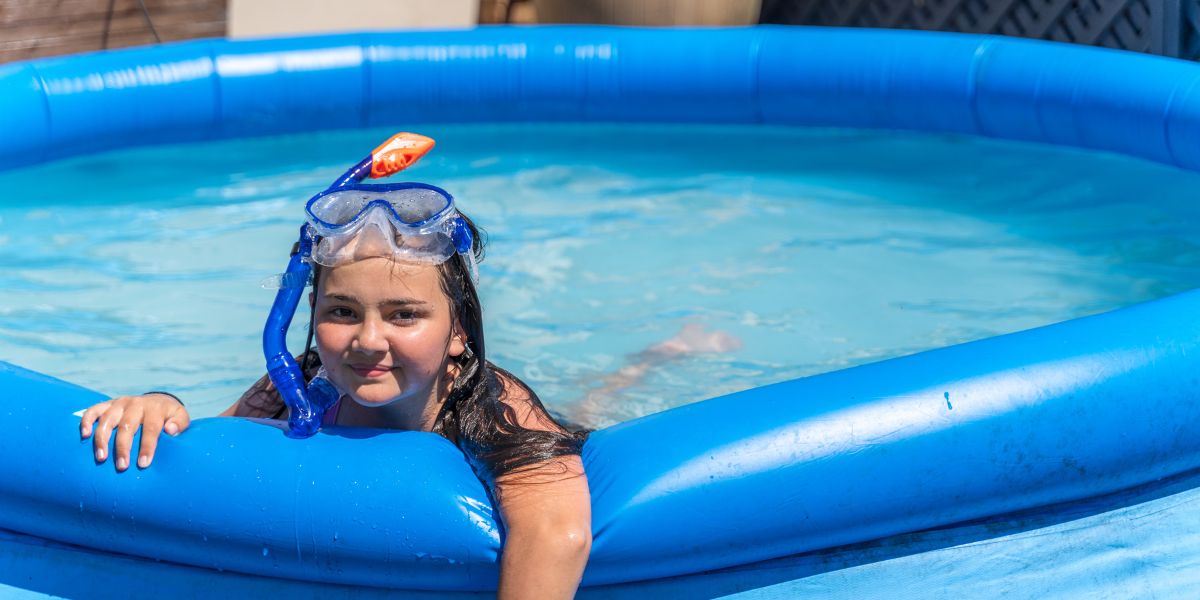
But they aren’t permanent, and you’ll likely need to store your pool away at some point. Even if you want to keep it in your yard for the long term, you’ll have to drain it every now and then to give it a good clean.
So, how do you do that? Let’s take a look.
How To Drain An Inflatable Pool With A Hose
Draining an inflatable pool with a hose is usually the preferred way to do it because it gives you a lot more control over where you drain the water.
And that’s important because you don’t want to cause a flood on your lawn, or leave large puddles of water in your yard that can’t drain properly. If you can use a hose, you can direct it to either plants that need to be watered (if the water is free from chemicals), or straight into a sewer drain.
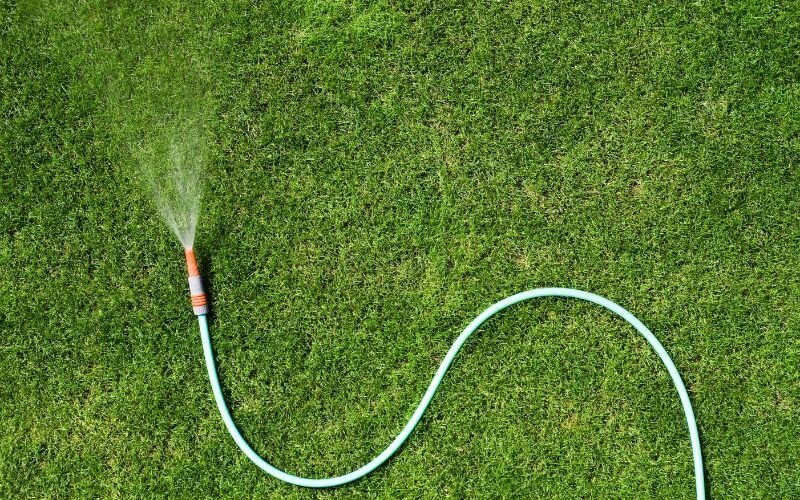
Using A Hose With A Valve
If your inflatable pool has a drain valve, then you just need to attach the hose to it. Some inflatable pools with a drain valve will come with a special hose, while others may just give you the attachment you need.
Once the hose is ready, open the drain plug. No water should leak yet because the valve hasn’t been pierced. As soon as you push the connector into the plug, the valve will open, and water will flow through the hose.
So, it’s a good idea to have the other end of your hose in the right place before you start the draining process. It’ll flow out quickly!
Using A Hose With No Valve
If you don’t have a drain valve, then you’ll need to siphon the water out of the pool. For this you’ll really need a self-priming siphon hose.
These are hoses that have a device inside – often a marble – that allows for the artificial suction to begin. It means you don’t need to suck on the other end of the hose to start the siphoning process.
For siphoning to work, the end of the hose where the water will be drained out of needs to be lower than the end that you place in the pool. Gravity is key for siphoning to work. So you might not be able to fully drain the pool by siphoning, but you can get most of the way before finishing with a bucket.
Place the non-valved end of the hose near the drain, and then with the other end, you want to insert it into the pool in a quick up-and-down motion, shaking it a few times.
This motion will start the suction process, which causes the water to siphon out. Make sure the hose stays in the water in the pool as it drains, but that it’s always higher than the other end.
How To Drain An Inflatable Pool Without A Hose
Sometimes you won’t be able to use a hose to drain your inflatable pool, and that’s OK – but there are a few things you need to be aware of.
Let’s take a look at the methods you can try, and any drawbacks.
Tip It Out
The absolute simplest way to drain an inflatable pool is to simply tip the water out. However, depending on the size of the pool, this might not be possible.
Filled pools are very heavy. This will only work for small pools and even then, only if there are a few of you working together.
While tipping the pool is the fastest option, there are a couple of drawbacks. Number one is that you’ll instantly flood the area around the pool.
If this is concrete or another hard surface, that’s fine if it drains away to a sewer naturally.
If it’s grass, then you may oversaturate it, which can damage it. Plus if the water has any chlorine in it, you could burn the lawn and kill the grass.
Also, in the process of tipping over a pool, you’re more likely to damage it. You need to do this carefully so that you don’t cause a puncture.
Open The Drain Plug
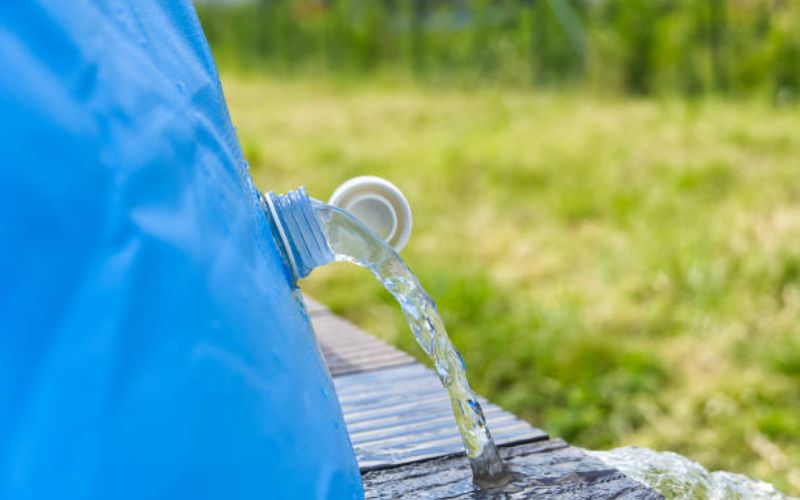
Some inflatable pools will have a drain plug that works just like the plug in a bathtub. Open it up, and the water floods out.
This tends to be slower than tipping the water out, but it’s also the easiest option with very little effort involved. But again, you have no control over where the water flows.
This could be even worse for grass because you’re really oversaturating a small area. At least when you tip a pool, you’re spreading water over a larger space.
Open The Drain Valve (Filtered Pools)
If your inflatable pool has a pump filter, then they often have a drain valve. When you open this and leave the pump filter running, the water will continue to be pumped around but it will escape from the open valve instead of continuing into the filter as normal.
This gives you a little more control, since you can move the filter before you open the valve, but you’re still restrained by the pump hoses. It’s faster than just letting the water drain out of a plug though.
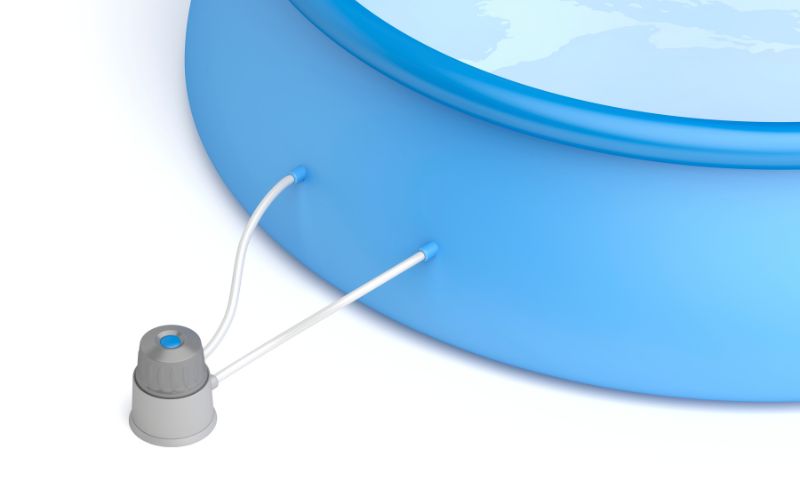
Deflate The Pool
One way to kick-start the draining process is to just let some air out of the pool. This will lower the sides, meaning that some of the water will naturally start to fall out.
You have the same concerns again about where the water will end up, and this won’t work with every pool. But it’s a good option to get things started, especially if you’re using a combination of methods.
Use A Wet/Dry Vacuum
A Wet/Dry Vacuum is a fantastic option for draining a pool. These are vacuums that allow you to suck up liquids into a tank, which you can then carry to a sewer to drain.
While these are easy to use, they don’t generally have a huge capacity, so you will have to make quite a few trips back and forth between the pool and the sewer drain.
Use A Bucket
Sometimes, the most basic options can’t be beaten. Yes, this will take a while, but almost everyone has a bucket (or something equivalent) around the home and you know exactly what needs to be done here.
And at least you won’t need to head to the gym on the day that you empty a pool with a bucket – you’ll have done plenty of exercise.
How To Drain An Inflatable Pool With A Pump
The most effective way to drain an inflatable pool is to use a pump. These use a hose to pump the water out of your pool quickly, but the drawback is that they’re more expensive.
However, if you’ve bought a good quality inflatable pool that you’ll be using regularly, buying a pump might also make sense, since it will make it much faster to empty and clean your pool every time you need to.
Why You Should Drain Your Pool
There are a few different reasons you might need to drain your pool.
1. Relocating the pool
You might decide that you want to move your pool. Maybe as the season has progressed, the sun doesn’t reach the same spots in your garden.
Or, if you’ve located your pool on grass, you want to move it so that you don’t kill the grass underneath. You’ll need to move your pool every few days if that’s the case.
2. To clean it
Cleaning the pool can be done using a skimmer and a filter pump, but for a proper clean you’ll want to empty it fully. If you’re leaving your inflatable pool in your yard for months at a time, you should drain it every couple of months for a deep clean.
Read more: How To Clean An Inflatable Pool
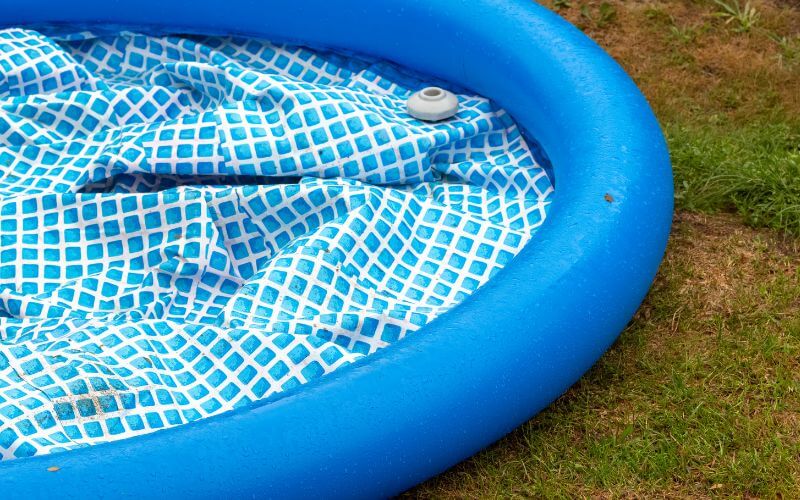
3. To check for leaks
If there’s a potential leak in the pool, it can be hard to always find it when it’s full of water. Instead, once you’ve emptied it you can use a mix of water and liquid detergent, and put that around the areas where you think there’s a leak. When you see lots of bubbles forming, you’ve found it.
Where You Should Drain Your Pool
You can use old pool water to water your garden or plants if you want to, as long as you’ve not used any chemical cleaners like chlorine. If you have added chlorine to water, the safest thing to do is to drain it into a sewer.
Chlorine does fade over time, so if you’ve not added it to the pool in around 5 days, you can test it. If the pH is 7.0 or above, then you know the acidic chlorine has neutralized, and you’re safe to use the water for your plants.

How To Store Your Pool Once Drained
If you’re draining your pool because you want to store it away, you have to make sure it’s fully dry before you fold it up. Leaving any moisture will lead to mold and mildew developing, which could smell and be hard to remove without chemicals.
And if you have to use a harsh chemical on your pool to clean it, then you may damage the integrity of the pool, making it more liable to leak in future.
So, always air out your pool (inside and out) and make sure it’s fully dry.
Then when you store it, make sure it’s protected and kept away from anywhere that a critter might get to – you don’t want to return to your pool next summer to find that a mouse has chewed through it.
Read more: How to Store an Inflatable Pool
Final Word
There are a lot of different ways you can drain a pool, some of which are easier and some of which require additional tools that you may need to buy.
The most important thing is to think about where the water ends up – you don’t want to accidentally kill your plants or lawn by drowning them or coating them in chlorine. Aim to use a hose if you can, just because it’s so much easier to drain it straight into the sewer when you do.



